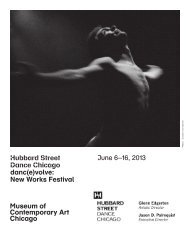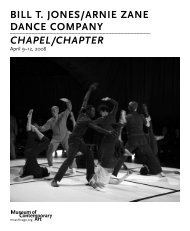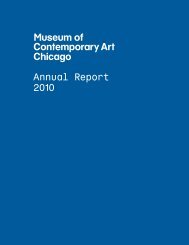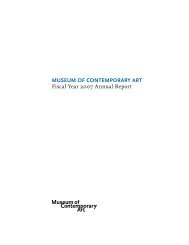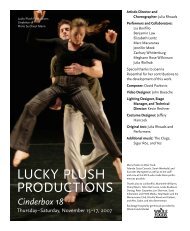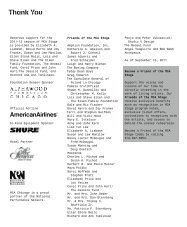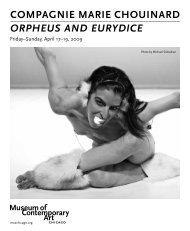Program Notes - Museum of Contemporary Art Chicago
Program Notes - Museum of Contemporary Art Chicago
Program Notes - Museum of Contemporary Art Chicago
You also want an ePaper? Increase the reach of your titles
YUMPU automatically turns print PDFs into web optimized ePapers that Google loves.
Photo: Julieta Cervantes<br />
Armitage Gone! Dance<br />
Thursday–<br />
Saturday,<br />
April 26–28,<br />
2012<br />
Edlis Neeson<br />
Theater
Armitage Gone! Dance<br />
Karole Armitage, <strong>Art</strong>istic<br />
Director<br />
Company<br />
Sara Beery<br />
Megumi Eda<br />
Sean Hilton<br />
Abbey Roesner<br />
Bennyroyce Royon<br />
Marlon Taylor-Wiles<br />
Emily Wagner<br />
Mei-Hua Wang<br />
Jacob Michael Warren<br />
Masayo Yamaguchi<br />
Alexandra Greenwald,<br />
Company Manager<br />
Christina Johnson,<br />
Rehearsal Director<br />
Hong Chen, Stage Manager<br />
Clifton Taylor,<br />
Lighting Designer<br />
GAGA-Gaku (2011)<br />
Music: Lois V Vierk, 五 Guitars<br />
(Go Guitars) and Red Shift<br />
Lighting Design: Clifton Taylor<br />
Costumes: 132 5. Issey Miyake<br />
Lanterns: David Salle<br />
Dancers: Sara Beery, Megumi<br />
Eda, Sean Hilton, Abbey<br />
Roesner, Bennyroyce Royon,<br />
Marlon Taylor-Wiles, Emily<br />
Wagner, Mei-Hua Wang, Jacob<br />
Michael Warren, Masayo<br />
Yamaguchi<br />
GAGA-Gaku draws upon<br />
the mysterious worlds <strong>of</strong><br />
Cambodian court dance,<br />
Japanese Noh Theater, and<br />
Balinese dance. The music is<br />
rooted in gagaku, the ancient<br />
court music <strong>of</strong> Japan. Antonin<br />
<strong>Art</strong>aud wrote in On The<br />
Balinese Theater in 1931 that<br />
“the drama does not develop<br />
as a conflict <strong>of</strong> feelings but <strong>of</strong><br />
states <strong>of</strong> mind—portraying<br />
the unleashing <strong>of</strong> cosmic forces<br />
and chaos waiting behind<br />
the mask <strong>of</strong> order we try to<br />
impose on life. It is an internal<br />
conflict.” Composer Lois V<br />
Vierk is a student <strong>of</strong> gagaku.<br />
Issey Miyake’s origami-based<br />
costumes are conceived<br />
in collaboration with a computer<br />
scientist and made<br />
with recycled materials.<br />
五 Guitars (Go Guitars) by Lois V<br />
Vierk was recorded by<br />
guitarist Seth Josel at Trace<br />
Elements Records in NYC, and<br />
engineered by Robert M. Poss.<br />
This recording originally<br />
appeared on Josel’s portrait CD<br />
Go Guitars (O.O. Discs).<br />
Red Shift by Lois V Vierk was<br />
recorded by Ted Mook, cello;<br />
Dave Seidel, electric guitar;<br />
James Pugliese, percussion; Lois V<br />
Vierk, synthesizer. From<br />
Tzadik CD 7056, used by permission<br />
<strong>of</strong> Tzadik.<br />
Intermission<br />
The Watteau Duets<br />
(1985/2009)<br />
Original Score: David Linton,<br />
The Simpleton’s Guide to the<br />
World’s Greatest Music<br />
Lighting Design: Clifton Taylor<br />
Costumes: Charles Atlas and<br />
Peter Speliopoulos<br />
Dancers: Abbey Roesner,<br />
Marlon Taylor-Wiles (April 26);<br />
Emily Wagner, Sean Hilton<br />
(April 27 and April 28)<br />
Musicians: TALIBAM! Matt<br />
Mottel and Kevin Shea<br />
The title for The Watteau Duets<br />
is a nod to French artist Jean-<br />
Antoine Watteau whose eighteenth-century<br />
paintings depict<br />
characters in the comedy <strong>of</strong><br />
love. In Armitage’s twentiethcentury<br />
look at the subject, the<br />
idealized baroque vision <strong>of</strong><br />
the delight is turned into what<br />
the French call an apache<br />
dance—a battle <strong>of</strong> the sexes<br />
depicted as a war dance with a<br />
sense <strong>of</strong> humor. Once ethereal,<br />
pointe shoes now are used as<br />
weapons. David Linton’s score<br />
was among the first to use<br />
sampling, mixing live music<br />
with recorded track.<br />
Intermission<br />
Drastic-Classicism<br />
(1981/2009)<br />
Original Score: Rhys Chatham,<br />
Drastic-Classicism<br />
Lighting Design: Clifton Taylor<br />
Costumes: Peter Speliopoulos<br />
and Karen Young<br />
Dancers: Sara Beery, Megumi
<strong>Art</strong>ists Up Close<br />
Eda, Sean Hilton, Abbey<br />
Roesner, Bennyroyce Royon,<br />
Marlon Taylor-Wiles, Emily<br />
Wagner, Mei-Hua Wang, Jacob<br />
Michael Warren, Masayo<br />
Yamaguchi<br />
Musicians: Steve Gunn, Matt<br />
Mottel, Kevin Shea, Shelly<br />
Steffens, Mike Vallera<br />
When Drastic-Classicism,<br />
one <strong>of</strong> Armitage’s signature<br />
works, premiered in New York<br />
thirty years ago it shocked<br />
audiences with its audacity:<br />
pairing ballet movement with<br />
the raw energy <strong>of</strong> punk’s wall<br />
<strong>of</strong> sound, rendered by Rhys<br />
Chatham. Yet, as Arlene Croce<br />
wrote at the time, “[c]lassical<br />
values that were flayed alive,<br />
stayed alive.”<br />
Armitage Gone! Dance’s 2011–2012<br />
Season is supported with public<br />
funds from the National<br />
Endowment for the <strong>Art</strong>s, New York<br />
State Council for the <strong>Art</strong>s, New<br />
York City Department <strong>of</strong> Cultural<br />
Affairs, The Fan Fox and Leslie<br />
R. Samuels Foundation, Shubert<br />
Foundation, LLWW Foundation,<br />
Gladys Krieble Delmas Foundation,<br />
Richard J. Massey Foundation for<br />
<strong>Art</strong>s and Sciences, Jerome Robbins<br />
Foundation, and others.<br />
This series brings together MCA Stage artists with the public<br />
over a variety <strong>of</strong> intimate conversations and training opportunities<br />
to provide insight into the creative process.<br />
First Night<br />
Thursday, April 26<br />
Following the opening-night performance, audience members are<br />
invited to join an insightful discussion with Karole Armitage, led by<br />
Peter Taub, Director <strong>of</strong> Performance <strong>Program</strong>s.<br />
Talk<br />
Saturday, April 28, 2 pm<br />
Karole Armitage and visual artist David Salle discuss their own<br />
works as well as collaborations with each other, and bring perspective<br />
to the climate and politics <strong>of</strong> art and dance in the 1980s<br />
and today. Salle’s paintings are in the current MCA exhibition,<br />
This Will Have Been: <strong>Art</strong>, Love & Politics in the 1980s. This rare<br />
public conversation is moderated by This Will Have Been guest<br />
curator Helen Molesworth. Tickets are $10, or $6 for students.<br />
Saturday Speakeasy<br />
April 28<br />
Following the performance, audience members are invited<br />
to mingle with the company in the lobby, with a cash bar and<br />
snacks available.
Dance<br />
Luna Negra<br />
Dance Theater<br />
Luna Nueva<br />
June 7–10, 2012<br />
Copresented with<br />
Luna Negra Dance Theater<br />
“Luna Negra’s dancers are<br />
in bravura form—fluid,<br />
bold, intense, funny and<br />
highly individualistic.”<br />
<strong>Chicago</strong> Sun-Times<br />
For tickets, visit mcachicago.org or call 312.397.4010.<br />
Photo: Jonathan Mack<strong>of</strong>f
About the <strong>Art</strong>ists<br />
Armitage Gone! Dance<br />
was formed in 2001, when Karole Armitage<br />
returned to the United States after fifteen years<br />
<strong>of</strong> working in Europe. For the first two years, the<br />
company created one production annually for<br />
seven dancers. This culminated in the creation<br />
<strong>of</strong> the company’s acclaimed ballet Time is<br />
the echo <strong>of</strong> an axe within a wood. Armitage<br />
Gone! Dance was <strong>of</strong>ficially launched in 2004<br />
with an unprecedented three-week season at<br />
the Duke on 42nd Street Theater, followed by<br />
a commissioned dance for Works & Process<br />
at the Guggenheim <strong>Museum</strong>. The excitement<br />
generated by these engagements led to<br />
performances in Italy, France, and Mexico,<br />
and then to tours throughout the United States<br />
and Europe for the next several years. In 2010,<br />
Armitage Gone! Dance became the ten-member<br />
company it is today.<br />
Armitage formed her first company, Armitage<br />
Gone!, in New York City in 1979 to critical<br />
acclaim. The company toured to festivals<br />
and venues worldwide, taking the name The<br />
Armitage Ballet in 1985, to perform works in<br />
collaboration with visual artists David Salle and<br />
Jeff Koons. Throughout the 1990s, Armitage<br />
chose to maintain her company on a project<br />
basis while accepting commissions from<br />
European ballet and opera companies. Armitage<br />
Gone! Dance has received a number <strong>of</strong><br />
prestigious awards and commissions including<br />
two National Dance Project Awards, support<br />
from the Doris Duke Charitable Foundation,<br />
a Multi-<strong>Art</strong>s Production Fund Award, and<br />
commissions from the Guggenheim’s Works and<br />
Process program, The Joyce Theater’s Cathy<br />
and Stephen Weinroth Fund for New Works,<br />
the Teatro Massimo Vincenzo Bellini di Catania,<br />
in Italy, Lincoln Center for Lincoln Center Out<br />
<strong>of</strong> Doors, Napoli Teatro Festival Italia, BAM<br />
for the 2009 Next Wave Festival, the Krannert<br />
Center for the Performing <strong>Art</strong>s at the University<br />
<strong>of</strong> Illinois at Urbana-Champaign, the Hopkins<br />
Center, Dartmouth College, and a commission<br />
for a new work from SummerStages for<br />
performances in Central Park. The company’s<br />
fall 2011 tour in Europe featured a ten-year<br />
retrospective <strong>of</strong> work.<br />
Karole Armitage<br />
is trained in classical ballet and began her pr<strong>of</strong>essional<br />
career in 1973 as a member <strong>of</strong> the<br />
Ballet du Théâtre de Genève, Switzerland, a<br />
company devoted exclusively to the repertory<br />
<strong>of</strong> George Balanchine. In 1976, she was invited<br />
to join Merce Cunningham’s company, where<br />
she remained for five years, performing leading<br />
roles in Cunningham’s landmark works.<br />
Armitage created her first piece in 1978, followed<br />
by Drastic-Classicism in 1981. Throughout<br />
the 1980s, she led her own New York–based<br />
dance company, Armitage Ballet. Following<br />
the premiere <strong>of</strong> The Watteau Duets at Dance<br />
Theater Workshop, Mikhail Baryshnikov invited<br />
her to create a work for the American Ballet<br />
Theater, and Rudolph Nureyev commissioned a<br />
work for the Paris Opera Ballet. She continued<br />
to work both in Europe and the United States<br />
until 1996 when she was appointed Director <strong>of</strong><br />
Maggiodanza in Florence, Italy. From 1999 to<br />
2004 she was the resident choreographer <strong>of</strong><br />
Ballet de Lorraine in France, and in 2005 served<br />
as Director <strong>of</strong> the Venice Biennale Festival <strong>of</strong><br />
<strong>Contemporary</strong> Dance. Her work continues to<br />
tour throughout the continent, performed by<br />
several European companies. After her company’s<br />
successful season at the Joyce in 2004,<br />
Armitage’s focus returned to her New York–<br />
based company.
Photo: Julieta Cervantes
Known as the “punk ballerina,” Armitage creates<br />
works that blend dance, music, and<br />
art and are inspired by disparate, non-narrative<br />
sources, from twentieth-century physics<br />
to sixteenth-century Florentine fashion, to pop<br />
culture and new media. She injects the classic<br />
vocabulary with speed, fractured lines,<br />
abstractions, and symmetry countermanded<br />
by asymmetry. She uses music as her script,<br />
frequently collaborating with contemporary<br />
and experimental composers such as Rhys<br />
Chatham, Vijay Iyer, Lukas Ligeti, and John<br />
Luther Adams, whose scores can be marked by<br />
extreme lyricism as well as dissonance,<br />
noise, and polyrhythms. The sets and costumes<br />
for her works are <strong>of</strong>ten designed by leading<br />
artists in the contemporary art world, including<br />
Jeff Koons, David Salle, Phillip Taaffe, and<br />
Brice Marden.<br />
As a true post-modernist, Armitage resides in<br />
both the esoteric and the popular, having<br />
choreographed two Broadway productions<br />
(Passing Strange and Hair, which garnered her<br />
a Tony® nomination), videos for Madonna and<br />
Michael Jackson, and several Merchant-Ivory<br />
films. In 2009, she was awarded France’s most<br />
prestigious award, Commandeur Dans L’orde<br />
Des <strong>Art</strong>s Et Des Lettres.<br />
She has choreographed new works for the<br />
Bolshoi Ballet in Moscow, American Ballet<br />
Theatre, the Paris Opera Ballet, White<br />
Oak Dance Project, the Deutsch Opera Berlin,<br />
the Bayerische Staatsoper in Munich, Les<br />
Ballets de Monte Carlo, Lyon Opera Ballet,<br />
Ballet Nacional de Cuba, the Washington<br />
Ballet, Alvin Ailey American Dance Theater,<br />
the Kansas City Ballet, the Bern Ballet<br />
and the Rambert Dance Company. She has<br />
directed operas from the baroque and<br />
contemporary repertoire for prestigious houses<br />
<strong>of</strong> Europe, including Teatro di San Carlo in<br />
Naples, Théâtre du Châtelet in Paris, the Lyric<br />
Opera in Athens, and Het Muzik Theater in<br />
Amsterdam. She choreographed The Cunning<br />
Little Vixen, directed by Doug Fitch, in 2011, for<br />
the New York Philharmonic.<br />
Her work has been the subject <strong>of</strong> two documentaries<br />
made for television: The South<br />
Bank Show (1985), directed by David Hinton,<br />
and Wild Ballerina (1988), directed by<br />
Mark Kidel. Upcoming projects include choreography<br />
for AmaLuna, the 2012 tent show<br />
by Cirque du Soleil.<br />
Rhys Chatham<br />
is originally from Manhattan, where he was<br />
the founder <strong>of</strong> the music program at The<br />
Kitchen. A composer, guitarist, and trumpet<br />
player, he is considered a founder <strong>of</strong> a<br />
fusion <strong>of</strong> the overtone-drenched minimalism<br />
<strong>of</strong> John Cale and Tony Conrad with the<br />
relentless elemental guitar <strong>of</strong> the Ramones.<br />
With Guitar Trio (1977), he was the first<br />
composer to make use <strong>of</strong> multiple electric<br />
guitars in special tunings to merge the<br />
extended-time music <strong>of</strong> the sixties and seventies<br />
with serious hard rock. This pursuit culminated<br />
in 1989 with the composition and performance<br />
<strong>of</strong> his first symphony for an orchestra <strong>of</strong> one<br />
hundred electric guitars, An Angel Moves Too<br />
Fast to See. He subsequently composed<br />
other works for large guitar orchestra, including<br />
A Crimson Grail in 2009 (written for 200<br />
guitars and 16 bass), which was released on<br />
Nonesuch Records in 2010. Chatham first<br />
worked with Karole Armitage in 1981 and has<br />
been based in Paris since 1987.
Christina Johnson<br />
was born in Vienna, Austria, and began dance<br />
studies at the age <strong>of</strong> seven. She trained at the<br />
Boston School <strong>of</strong> Ballet, the School <strong>of</strong> American<br />
Ballet, and the Dance Theatre <strong>of</strong> Harlem. Her<br />
pr<strong>of</strong>essional debut with the Boston Ballet was<br />
followed by Dance Theatre <strong>of</strong> Harlem, where<br />
she rose to become a principal dancer during<br />
her thirteen-year tenure and performed leading<br />
roles in Swan Lake, Giselle, Firebird, Prodigal<br />
Son, and The Four Temperaments. Johnson has<br />
worked with choreographers such as Jerome<br />
Robbins, Frederic Franklin, Suzanne Farrell,<br />
and Sir Anthony Dowell. As a member <strong>of</strong> Le<br />
Ballet du Grand Théâtre de Genève and Ballet<br />
Basel, her repertoire expanded with works by<br />
William Forsyth, Jiri Kylian, James Kudelka,<br />
Ohad Naharin, Jean-Christophe Maillot, Twyla<br />
Tharp, Amanda Miller, and David Parsons, to<br />
name a few. She has been a featured guest<br />
artist with the Royal Ballet <strong>of</strong> London and other<br />
companies. Johnson is a founding member <strong>of</strong><br />
Complexions <strong>Contemporary</strong> Ballet and made<br />
her Broadway debut in The Red Shoes.<br />
Her teaching, coaching, and ballet master<br />
career includes work with companies such as<br />
the Washington Ballet, Pittsburgh Ballet Theater,<br />
J<strong>of</strong>fery Ballet, Alvin Ailey American Dance<br />
Theater, Dance Theatre <strong>of</strong> Harlem, Complexions<br />
<strong>Contemporary</strong> Ballet, North Carolina Dance<br />
Theater, Cedar Lake <strong>Contemporary</strong> Ballet,<br />
Gotesborg Ballet, Ballet Basel, and Les Ballets<br />
Trockadero de Monte Carlo. She was rehearsal<br />
director for Cedar Lake <strong>Contemporary</strong><br />
Ballet from 2005 to 2006. She joined Armitage<br />
Gone! Dance as rehearsal director in 2010,<br />
and is on the guest faculty at the Princeton<br />
Dance and Theater Studio and at Greenwich<br />
Ballet Academy.<br />
Issey Miyake<br />
was born in Hiroshima, Japan, in 1938. He<br />
established the Miyake Design Studio in<br />
1970 and started to show his line at the Paris<br />
Collections in 1973. Miyake’s tenets for making<br />
clothes has always been the idea <strong>of</strong> creating<br />
a garment from one piece <strong>of</strong> cloth and the<br />
exploration <strong>of</strong> the space between the human<br />
body and the cloth that covers it. His approach<br />
to design is to strike a consistent balance<br />
between tradition and innovation, handcrafts<br />
and new technology. 132 5. Issey Miyake<br />
is his new creative challenge based on the<br />
ideas <strong>of</strong> regeneration and Re-creation<br />
and a continuation <strong>of</strong> his perpetual search for<br />
new ways by which to make “clothes that<br />
bring joy and happiness to wearers.”<br />
Peter Speliopoulos<br />
is a native <strong>of</strong> Springfield, Massachusetts, and<br />
received his BFA from the Parsons School<br />
<strong>of</strong> Design in 1982. He began his collaboration<br />
with Karole Armitage designing costumes<br />
for the Athens production <strong>of</strong> Aristophanes’s<br />
The Birds in 2000. He has created the costumes<br />
for Schrodinger’s Cat, Drastic Remix, Rave,<br />
Melodien, SZ110 . . . la sonate and Sonata<br />
di Caccia (all for Ballet de Lorraine, Nancy,<br />
France); Living Toys (Rambert Dance Company,<br />
London); and Nadaswaram, Time is the<br />
echo <strong>of</strong> an axe within a wood, Ligeti Essays,<br />
Connoisseurs <strong>of</strong> Chaos, and Summer <strong>of</strong> Love<br />
(Armitage Gone! Dance, New York). For<br />
operas directed by Armitage, he has designed<br />
costumes for Bartok’s Bluebeard’s Castle<br />
(Opera de Lorraine, Nancy, France), Gluck’s<br />
Orfeo ed Euridice (Teatro di San Carlo, Naples,<br />
Italy), Rameau’s Pygmalion (Theatre du<br />
Chalet, Paris), and Ariadne Unhinged (Gotham<br />
Chamber Opera, New York). In 2002, he
eturned to New York to continue his work in<br />
fashion design. He is Senior Vice President <strong>of</strong><br />
Design and Creative Director <strong>of</strong> Donna Karan.<br />
He is former Creative Director <strong>of</strong> Cerruti <strong>Art</strong>e,<br />
Paris (1997–2002), and Senior Design Director<br />
<strong>of</strong> Donna Karan (1993–97).<br />
Clifton Taylor<br />
has designed lighting for Karole Armitage in<br />
productions in Italy, France, the United Kingdom,<br />
Monaco, and New York over the past decade.<br />
His Broadway credits include Jay Johnson:<br />
The Two and Only (Ovation & LA Drama Critics<br />
Circle Nominations); Frozen (Lortel Nomination)<br />
and Hot Feet (Henry Hewes Nomination).<br />
Off-Broadway credits include Freud’s Last<br />
Session, Frozen, Scattergood, Endgame, The<br />
Streets <strong>of</strong> New York, and Last Easter. Other<br />
credits include Houston’s Alley Theater,<br />
Tanglewood Music Center, Opera de Lorraine et<br />
Nancy (Théâtre du Châtelet, Paris), New York<br />
City Opera/National Company, the American<br />
Conservatory Theater (San Francisco), the<br />
Dallas Theater Center, the Irish Repertory<br />
Theater (New York), and New York’s MCC<br />
Theater. He is a frequent designer at the Joyce<br />
Theater, having designed lighting for Elisa<br />
Monte, Philadanco, Jacqulyn Buglisi, and Larry<br />
Keigwin, among many others.<br />
Lois V Vierk<br />
studied music composition at California Institute<br />
<strong>of</strong> the <strong>Art</strong>s, and studied and performed gagaku<br />
(Japanese court music) for twelve years in<br />
California and Tokyo. She has spent most <strong>of</strong><br />
her career in New York City. Recently, her work<br />
was performed in a Portrait Concert at German<br />
Radio. Vierk has been commissioned by many<br />
performers and presenters, including Lincoln<br />
Center Festival, Kronos Quartet, Bang On A<br />
Can, Ensemble Modern, and Music From Japan.<br />
Her co-creations with tap dance choreographer<br />
Anita Feldman have been performed at both<br />
music and dance venues worldwide.<br />
Dancers<br />
Sara Beery<br />
was born in Seattle, Washington, and began<br />
her dance training at Spectrum Dance Theatre<br />
and later at the Cornish College <strong>of</strong> the <strong>Art</strong>s<br />
Preparatory Dance <strong>Program</strong>. She graduated<br />
early from high school and received a full<br />
scholarship to the Atlanta Ballet Centre for<br />
Dance Education, where she danced with the<br />
school the first year and was then <strong>of</strong>fered a<br />
fellowship with the Atlanta Ballet under the<br />
direction <strong>of</strong> John McFall. During her two years<br />
with the company she performed works by<br />
Lauri Stallings, Victor Quihada, James Kudelke,<br />
George Balanchine, Mark Godden, and Michael<br />
Pink, among others. She continues summer<br />
studies at the Alonzo King LINES Ballet and the<br />
Jacobs Pillow Summer Dance <strong>Program</strong>, where<br />
she performed a world premiere by Karole<br />
Armitage. This is Beery’s second season with<br />
Armitage Gone! Dance.<br />
Megumi Eda<br />
was born in Nagano, Japan, and made her<br />
pr<strong>of</strong>essional debut with the Matsuyama Ballet<br />
Company in Tokyo, where she appeared<br />
in many <strong>of</strong> the ballet classics in repertoire. In<br />
1992, she was invited to join the Hamburg<br />
Ballet School, and soon after she joined the<br />
company, where she worked with Mats Ek<br />
and choreographer/director John Neumeier.<br />
In 1997, Eda joined the Dutch National Ballet<br />
where she worked with Twyla Tharp, Hans<br />
van Manen, Rudi Van Dantzig, William Forsythe,
and Redha. In 2001 she moved to London to<br />
dance with the Rambert Dance Company. There<br />
she worked with Christopher Bruce, Jiri Kylian,<br />
and Lindsey Kemp, and choreographed her<br />
first two pieces, for the Rambert Company. In<br />
2002, Eda was awarded “Best New <strong>Art</strong>ist”<br />
by Japanese national newspaper, Shinano<br />
Mainichi Shimbun. In 2004 she won a Bessie<br />
for her performance in Armitage’s Time is the<br />
echo <strong>of</strong> an axe within the wood. She recently<br />
worked with Yasuko Yokoshi and film director<br />
Abe Abraham. This is Eda’s ninth season with<br />
Armitage Gone! Dance.<br />
Sean Hilton<br />
is a former member <strong>of</strong> River North <strong>Chicago</strong><br />
Dance Company, where he performed works<br />
by Lauri Stallings, Kevin Iaega Jeff, Harrison<br />
MacEldowney, and Lynne Taylor-Corbett,<br />
among others. Previously he danced with the<br />
Bay Area Houston Ballet under the direction<br />
<strong>of</strong> George De La Pena, and the Columbia<br />
Classical Ballet under the direction <strong>of</strong> Radenko<br />
Pavlovich. He also teaches dance and choreographs<br />
extensively throughout the United States,<br />
with faculty posts at the University <strong>of</strong> South<br />
Carolina, the Northwest Florida Ballet, Ballet<br />
Tennessee, Thodos Dance <strong>Chicago</strong>, River North<br />
<strong>Chicago</strong> Dance Company, and the Lou Conte<br />
Dance School. He is a guest artist with Lauri<br />
Stallings gloATL. This is Hilton’s second season<br />
with Armitage Gone! Dance.<br />
Abbey Roesner<br />
was born in Baltimore, Maryland. She began<br />
her dance training at the Baltimore School for<br />
the <strong>Art</strong>s in the T.W.I.G.S. program (To Work<br />
In Gaining Skills), eventually enrolling full time<br />
at BSA for grades 9–12, graduating second<br />
in her class. She received her BFA in 2006<br />
from the Juilliard School. Her freelance work<br />
includes dancing with companies and<br />
choreographers such as the Metropolitan<br />
Opera Ballet and the Chamber Dance Project,<br />
Wally Cardona, and Davis Robertson. In<br />
2007 she joined Les Grands Ballets Canadiens<br />
de Montreal and performed works by Ohad<br />
Naharin, Stijn Celis, George Balanchine, and<br />
Fernand Nault on the company’s tour throughout<br />
Canada and Europe. Roesner assists with<br />
teaching and recruitment for Elliot Feld’s Ballet<br />
Tech School. This is Roesner’s fourth season<br />
with Armitage Gone! Dance.<br />
Bennyroyce Royon<br />
was born in the Philippines and began his<br />
pr<strong>of</strong>essional dance training at sixteen, under the<br />
tutelage <strong>of</strong> Wade Walthall, at the Evergreen<br />
City Ballet Academy in Auburn, Washington.<br />
In 2006 he received his BFA from the Juilliard<br />
School, where he danced in notable works<br />
by José Limon, Paul Taylor, Mark Morris, and<br />
in world premieres by Jessica Lang, Jacqulyn<br />
Buglisi, Ron Brown, Eliot Feld, Alan Hineline,<br />
and Jill Johnson. His freelance work includes<br />
dancing with Carolyn Dorfman Dance Company,<br />
the Metropolitan Opera Ballet, Sidra Bell Dance<br />
NY, and Collective Body Dance Lab. Royon is<br />
a founding member <strong>of</strong> Rasta Thomas’s all-male<br />
dance company, Bad Boys <strong>of</strong> Dance. He has<br />
toured Canada and Europe with Cas Public, a<br />
Montréal-based contemporary dance company.<br />
He has taught dance in Seattle, New York<br />
City, and Montréal, as well as at Jacob’s Pillow,<br />
and has received choreographic commissions<br />
from the Evergreen City Ballet, Bad Boys <strong>of</strong><br />
Dance, the Juilliard School, and most recently<br />
Atlanta Ballet. Royon produces dance projects<br />
under his collaborative group Bennyroyce<br />
Dance Productions, which he founded in 2006.
Photo: Julieta Cervantes
This is Royon’s fourth season with Armitage<br />
Gone! Dance.<br />
Marlon Taylor-Wiles<br />
was born in Houston, Texas, where he trained<br />
with the Margo Marshall School <strong>of</strong> Ballet under<br />
the direction <strong>of</strong> Margo Marshall and Mary<br />
Elizabeth Arrington. He graduated from<br />
Houston’s High School for the Performing and<br />
Visual <strong>Art</strong>s and in 2007 received his BFA from<br />
the Boston Conservatory. While attending the<br />
Boston Conservatory on full scholarship, he performed<br />
works by such notable choreographers<br />
as José Limon, Paul Taylor, and Luis Fuente.<br />
For the last five years Taylor-Wiles has dedicated<br />
himself to Tony Williams’s urban Nutcracker,<br />
which fuses Duke Ellington’s Nutcracker suite<br />
with Tchaikovsky’s classic score and is set<br />
in an inner city. In 2009 he performed for the<br />
Africa and International Friends Inaugural Ball<br />
in National Harbor, Maryland, honoring the<br />
inauguration <strong>of</strong> President Barack Obama. His<br />
freelance work includes dancing for a production<br />
with Beyoncé, and modeling for a ten-page<br />
feature with Chanel Iman for Elle Italia and for a<br />
photo shoot with Dree Hemingway for the magazine<br />
I-D. He was also nominated “25 to watch in<br />
2012” by Dance Magazine. This is Taylor-Wiles’s<br />
third season with Armitage Gone! Dance.<br />
Emily Wagner<br />
studied under scholarships at the Flint Youth<br />
Ballet, Virginia School <strong>of</strong> the <strong>Art</strong>s, and the<br />
American Ballet Theatre School, and under<br />
Sabrina Pillars, a mentor from the New York<br />
City Ballet. She has performed nationally and<br />
internationally with companies such as Ballet<br />
Austin, Eglevsky Ballet, Ballet Noir, Terra<br />
Firma Dance Theater, International Ballet<br />
Theater, and BalletX in Philadelphia. She<br />
appeared in Peter Breuer’s Bolero in Salzburg,<br />
Austria, with the Salzburg Ballet (2005), and<br />
as a soloist with the Movement Network <strong>of</strong><br />
Amsterdam, the Netherlands (2005–07.) During<br />
this time she received an international Pilates<br />
certification with Body <strong>Art</strong>s and Sciences<br />
International. Her freelance work includes dancing<br />
as a tango artist with the New Generation<br />
Dance Company and guest artist with the<br />
Pennsylvania Ballet, and modeling for Sansha<br />
and KD dance. This is Wagner’s third season<br />
with Armitage Gone! Dance.<br />
Mei-Hua Wang<br />
is originally from Taiwan. She trained at the<br />
National Taiwan Academy <strong>of</strong> <strong>Art</strong>s and received<br />
her MFA from the National Institute <strong>of</strong> <strong>Art</strong>s.<br />
She performed as a principal dancer with<br />
Capital Ballet Taipei and Taipei Ballet Company,<br />
and has been a guest artist with Korea Universal<br />
Ballet Company, Peking Central Opera<br />
Ballet, and Ballet Moderno y Folklorico de<br />
Guatemala. Since moving to New York in 1999,<br />
Wang has performed and worked with Igal<br />
Perry/Peridance Ensemble, Rebecca Kelly<br />
Ballet, Stephen Petronio, Earl Mosely, Sue<br />
Bernhard Danceworks, Silver-Brown Dance,<br />
and Williamsworks, among others. Her first choreographic<br />
commission premiered in May 2006<br />
for the Capital Ballet Taipei. This is Wang’s sixth<br />
season with Armitage Gone! Dance.<br />
Jacob Michael Warren<br />
recently earned his BFA in dance from<br />
Marymount Manhattan College, where he performed<br />
works by Christopher d’Amboise,<br />
Edgar Zendejas, and David Parsons. Since<br />
graduation, he has worked with TAKEdance,<br />
under the direction <strong>of</strong> Takehiro Ueyama and<br />
Jill Echo. He has also danced with the
Connecticut Ballet, Benjamin Briones Ballet,<br />
and the Steps on Broadway Repertory<br />
Ensemble. He is a founding member <strong>of</strong> Missing<br />
Eye Physical Theatre, a multimedia production<br />
company. Additionally Warren is a<br />
dedicated harmonica and saxophone player<br />
and member <strong>of</strong> a blues band based in<br />
New York. This is Warren’s first season with<br />
Armitage Gone! Dance.<br />
Masayo Yamaguchi<br />
was born in Nagano, Japan. She started her<br />
ballet training with Tamae Tsukada, and has<br />
a BFA in dance education from the University<br />
<strong>of</strong> Central Oklahoma. She has performed in<br />
Austria, Hungary, Slovakia, and Japan, notably<br />
the “pas de trios” in Swan Lake with the<br />
Leningrad Ballet’s tour to Nagano. At UCA<br />
she was a member <strong>of</strong> Kaleidoscope Dancers<br />
Company and received the Kaleidoscope Dance<br />
Award in 2003. She moved to New York and<br />
joined Faune Dance Troupe the same year.<br />
Before joining the company she was a guest<br />
dancer with Armitage Gone! Dance for engagements<br />
at the Duke on 42nd Street Theater<br />
(2005), the Joyce Theater (2007), and Lincoln<br />
Center Out <strong>of</strong> Doors (2008.) This is Yamaguchi’s<br />
fourth season with Armitage Gone! Dance.<br />
Armitage Foundation<br />
Board <strong>of</strong> Directors<br />
David Salle, Chairman<br />
Karole Armitage<br />
Lorinda Ash<br />
Dominique Lévy<br />
Richard Massey<br />
Donald Rosenfeld<br />
Peter Speliopoulos<br />
Giovanni Spinelli<br />
Robert L. Turner<br />
Armitage Gone! Dance<br />
Staff<br />
Karole Armitage,<br />
<strong>Art</strong>istic Director<br />
Alexandra<br />
Greenwald,<br />
Company Manager<br />
Christina Johnson,<br />
Rehearsal Director<br />
Sallie Sanders,<br />
Development Manager<br />
Lucy Mallett,<br />
Fiscal Manager<br />
Armitage Gone! Dance<br />
is a 501(c)(3)<br />
nonpr<strong>of</strong>it organization.<br />
ARMITAGE GONE! DANCE<br />
437 Madison Avenue, 37th<br />
Floor, NYC, 10022<br />
212.431.4314<br />
info@armitagegonedance.<br />
org<br />
www.armitagegonedance.org
Courtesy<br />
Guidelines and<br />
Information<br />
As one <strong>of</strong> the nation’s largest multidisciplinary museums devoted to<br />
the art <strong>of</strong> our time, the <strong>Museum</strong> <strong>of</strong> <strong>Contemporary</strong> <strong>Art</strong> <strong>Chicago</strong> <strong>of</strong>fers<br />
exhibitions <strong>of</strong> the most thought-provoking art <strong>of</strong> today. The museum’s<br />
performing arts program, MCA Stage, is the most active presenter <strong>of</strong><br />
theater, dance, and music in <strong>Chicago</strong>, featuring leading performers<br />
from around the globe in our 300-seat theater.<br />
MCA Stage is committed to presenting groundbreaking performances<br />
that focus on collaboration; working closely with artists; converging<br />
with the larger programming <strong>of</strong> the museum; and <strong>of</strong>fering a contemporary<br />
view <strong>of</strong> the traditional roots <strong>of</strong> performance.<br />
Parking<br />
Validate your ticket at coat<br />
check for $11 parking in the MCA<br />
garage (220 E. <strong>Chicago</strong> Avenue)<br />
and Bernardin garage (747 N.<br />
Wabash). The $11 parking is<br />
limited to six hours on date<br />
<strong>of</strong> performance.<br />
Lost and found<br />
To inquire about a lost item,<br />
call the museum at 312.280.2660.<br />
Unclaimed articles are held for<br />
30 days.<br />
Mary Ittelson,<br />
Chair <strong>of</strong> the Board <strong>of</strong><br />
Trustees<br />
Madeleine Grynsztein,<br />
Pritzker Director<br />
Janet Alberti,<br />
Deputy Director<br />
Michael Darling,<br />
James W. Alsdorf Chief<br />
Curator<br />
Performance Committee<br />
Lois Eisen, Chair<br />
Katherine A. Abelson<br />
Ellen Stone Belic<br />
Pamela Crutchfield<br />
Ginger Farley<br />
Gale Fischer<br />
Jay Franke<br />
John C. Kern<br />
Lisa Yun Lee<br />
Elizabeth A. Liebman<br />
Lewis Manilow<br />
Alfred L. McDougal<br />
Paula Molner<br />
Sharon Oberlander<br />
Maya Polsky<br />
D. Elizabeth Price<br />
Carol Prins<br />
Cheryl Seder<br />
Patty Sternberg<br />
Richard Tomlinson<br />
Performance <strong>Program</strong>s<br />
Peter Taub, Director<br />
Yolanda Cesta Cursach,<br />
Associate Director<br />
Surinder Martignetti, Manager<br />
Antonia Callas, Assistant<br />
Kevin Brown,<br />
House Management Associate<br />
Alicia M Graff,<br />
House Management Associate<br />
Quinlan Kirchner,<br />
House Management Associate<br />
Eboni Senai Hawkins, Intern<br />
Theater Management<br />
Dennis O’Shea,<br />
Manager <strong>of</strong> Technical<br />
Production<br />
Richard Norwood,<br />
Theater Production Manager<br />
Box Office<br />
Matti Allison, Manager<br />
Phongtorn Phongluantum,<br />
Assistant Manager<br />
Molly Laemle, Coordinator<br />
Jena Hirschy, Associate<br />
Lucy Pearson, Associate<br />
Gabriel Garcia, Associate<br />
<strong>Program</strong> notes compiled by<br />
Yolanda Cesta Cursach<br />
Seating<br />
Switch <strong>of</strong>f all noise-making<br />
devices while you are in<br />
the theater.<br />
Late arrivals are seated at the<br />
management’s discretion. Food<br />
and open beverage containers are<br />
not allowed in the seating area.<br />
Reproduction<br />
Unauthorized recording and<br />
reproduction <strong>of</strong> a performance<br />
is prohibited.<br />
<strong>Museum</strong> <strong>of</strong> <strong>Contemporary</strong> <strong>Art</strong><br />
<strong>Chicago</strong><br />
220 E. <strong>Chicago</strong> Avenue<br />
<strong>Chicago</strong>, Illinois 60611<br />
mcachicago.org<br />
General information 312.280.2660<br />
Box <strong>of</strong>fice 312.397.4010<br />
Volunteer for performances<br />
312.397.4072<br />
housemanagers@mcachicago.org<br />
Contact the Performance department<br />
housemanagers@mcachicago.org<br />
<strong>Museum</strong> hours<br />
Tuesday: 10 am–8 pm<br />
Wednesday–Sunday: 10am–5pm<br />
Closed Mondays, Thanksgiving,<br />
Christmas, and New Year’s Day



